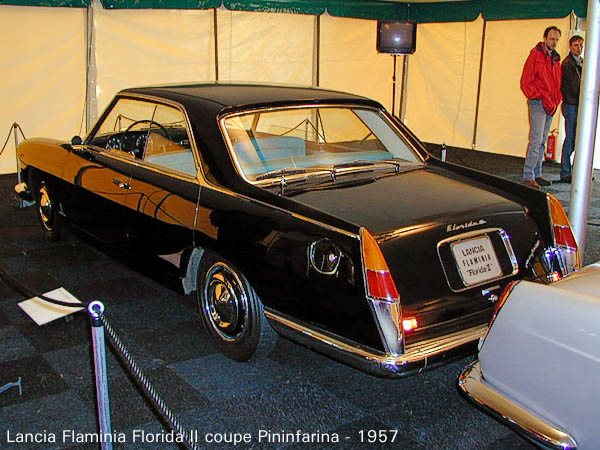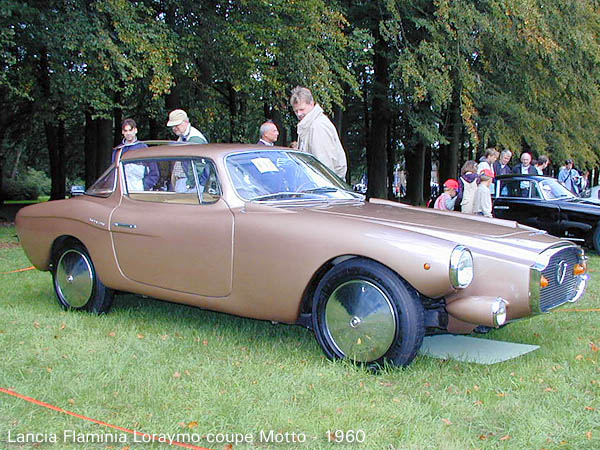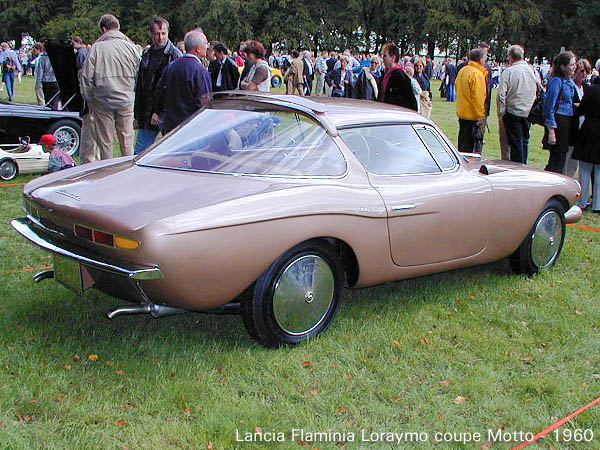In contrast to that of the Aurelia the chassis of the Flaminia wasn't made available commercially. This meant that there were far less Flaminia specials built, obviously because Lancia wanted to cover most of the market themselves. This left only room for some one-off prototypes and showcars based on the Flaminia. Most important and best known of these was of course the Florida II by Pininfarina; the 4-door coupe which lead to the Flaminia Coupe production model.
 The Florida II was presented at the 1957 Turin Motor Show and, though named Flaminia, was actually based on an adapted Aurelia B56 platform with a 2266 cc V6 engine developing 87 hp @ 4800 rpm. Lancia preferred to call it a pre-production Flaminia chassis however. Battista "Pinin" Farina, founder of the carrozzeria, regarded the Florida II as his best work and used this fully functional car as his personal transport. He practically lived in it, he stated on numerous occasions.
The Florida II was presented at the 1957 Turin Motor Show and, though named Flaminia, was actually based on an adapted Aurelia B56 platform with a 2266 cc V6 engine developing 87 hp @ 4800 rpm. Lancia preferred to call it a pre-production Flaminia chassis however. Battista "Pinin" Farina, founder of the carrozzeria, regarded the Florida II as his best work and used this fully functional car as his personal transport. He practically lived in it, he stated on numerous occasions.
Certainly the Florida II showed the essence of what was to become the fashionable style in European car manufacture during the 1960s: slab-side body ending in sharp but tasteful fins, sparse yet effective use of chrome trim, an angled and slim-pillared roof section and a front with a wide grill. Quite a change from the swooping fenders, ornamental grills and round shapes with turret-style windows which were common only years before. This prototype was the culmination of the small series of Florida models made by Pininfarina which had started in 1955 and marked a change in automotive design, a breakaway from tradition.
Looks were deceiving in regard to the Florida II: it looked like a roomy coupe while in fact it was a pillarless 4-door hardtop. The doors to the rear seats were craftily concealed and opened, as in the preceding Florida berlinas, opposed to the (larger) front doors.
 Next prototype to appear on the Flaminia platform was the 4-seater convertible by Vignale in 1958. Though prestigious looking it was less convincing than Pininfarina's Florida II and Lancia management decided against developing it into a production model.
Next prototype to appear on the Flaminia platform was the 4-seater convertible by Vignale in 1958. Though prestigious looking it was less convincing than Pininfarina's Florida II and Lancia management decided against developing it into a production model.
In 1960 the wildest Flaminia prototype was first shown: the Loraymo coupe from the studios of Raymond Loewy and realized in aluminum by carrozzeria Motto in Italy. Loewy was a French born artist who had established one of the leading industrial design studios in the USA. This studio designed all sorts of things: from logos to packaging and from office equipment to cars. These designs were usually attributed to Loewy while often he was just the promotor and had an elaborate staff of gifted designers to back him up.
During the 1940s and 1950s the Loewy Studios had put their mark on Studebaker design, which was very advanced and influential at the time. Mid 1950s Loewy turned away from Studebaker and created a number of showcars with sport coupe styling. The Loraymo was one of those; it followed a 1957 BMW 507 coupe prototype with excessive "coke-bottle" curves at the sides and actually preceded the famous 1963 Studebaker Avanti.
Styling-wise the Loraymo was sort of the intermediate model between Loewy's exuberant BMW 507 special and the elegant and balanced Studebaker Avanti; aspects of both can be found in it without it being much alike. Why exactly Loewy chose the Flaminia 2.5 litre V6 (tuned by Nardi to produce 140 hp) platform for this special is unclear, perhaps he wanted some Italian flair to rub off on the design.
 Coke-bottle style sweeping curves had become a characteristic styling feature in Loewy designs, not that strange because the Loewy studios had designed the classic shape of the (small) Coca-Cola bottle. It became very popular and common in American car design from the mid 1960s but it was still quite unusual when the Loraymo was presented at the Paris Motor Show. Another important innovation shown on the Loraymo was the roof spoiler which was placed above the rear window. This must have been a first at the time and it was decades ahead of its time.
Coke-bottle style sweeping curves had become a characteristic styling feature in Loewy designs, not that strange because the Loewy studios had designed the classic shape of the (small) Coca-Cola bottle. It became very popular and common in American car design from the mid 1960s but it was still quite unusual when the Loraymo was presented at the Paris Motor Show. Another important innovation shown on the Loraymo was the roof spoiler which was placed above the rear window. This must have been a first at the time and it was decades ahead of its time.
Additional distinctive features were the jet-like nose flanked by cutaway and recessed fenders and the small air intake placed to one side of the hood. This last detail returned on many other car designs. Loewy has used the Loraymo as his personal car quite like Pinin Farina did with the Florida II before. Much later on it came into the possession of Lancia's factory museum, which proves its importance, however odd it might look.
Yet another important Flaminia special was introduced in 1960, and this one was actually built in a small series: the Flaminia 335 Presidenziale. It was the new state limousine for the Italian government, a stretched 7-seater landaulet with a 335 cm wheelbase built by Pininfarina. Six of these elegant cars were made (including one for Pope John XIII) and its first official appearance was during Queen Elizabeth II of Great Britain's visit to Italy in 1961. This stressed the prestigious image of the Flaminia as Italy's most stately car at the time and the limousines were used on official state business for decades.
In 1962 Carrozzeria Boneschi presented the Flaminia Spider Amalfi, a squarish open 2-seater by designer Rodolfo Bonetto. Pininfarina put in one more prototype in 1963 with the 2-seater Flaminia 3B 2,8 Coupe Speciale, based on the short wheelbase chassis of the Flaminia GT, but this remained a one-off showcar. Concluding the specials in style was the 1969 Flaminia 3C 2,8 Marica coupe by Ghia. Where the Florida II had introduced the style of the 1960s the Marica can be regarded as a precursor to the style of the 1970s. It was a great looking 2-seater sport coupe with modern straight lines, a squared-off rear end, a long tapering nose and a trapezoid roof profile. Apparently Lancia owner Pesenti commissioned it in order to lure Ford into buying Lancia. This didn't happen but it impressed Ford enough to buy Carrozzeria Ghia. The good looks of the Marica returned on cars like the DeTomaso Longchamp and the Maserati Kyalami in the 1970s.
